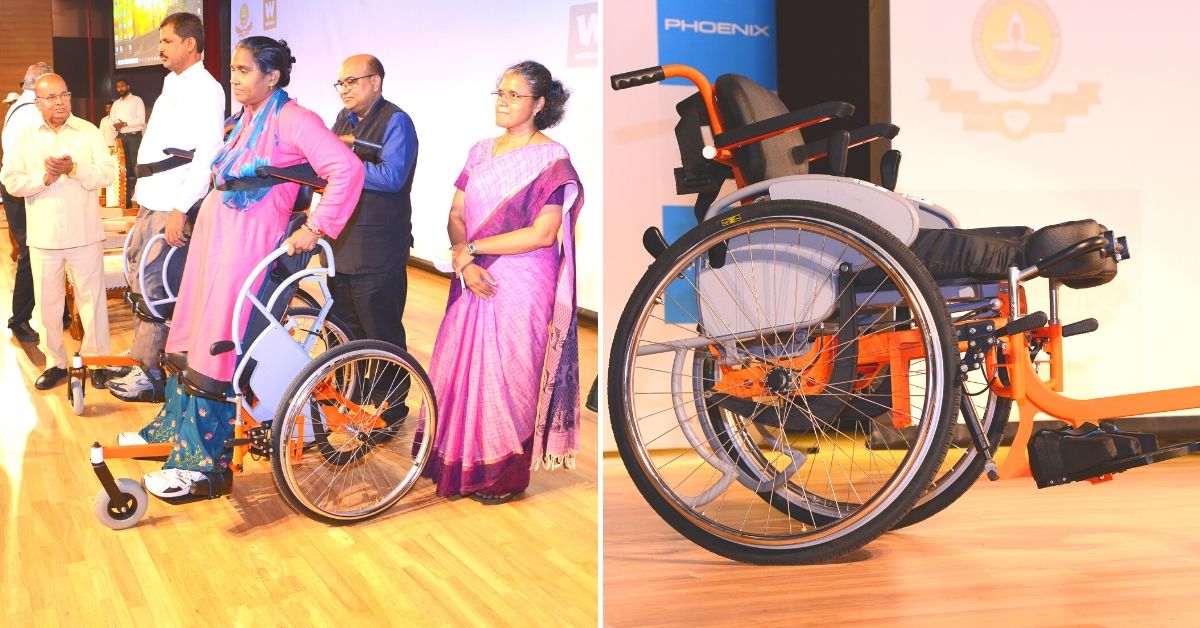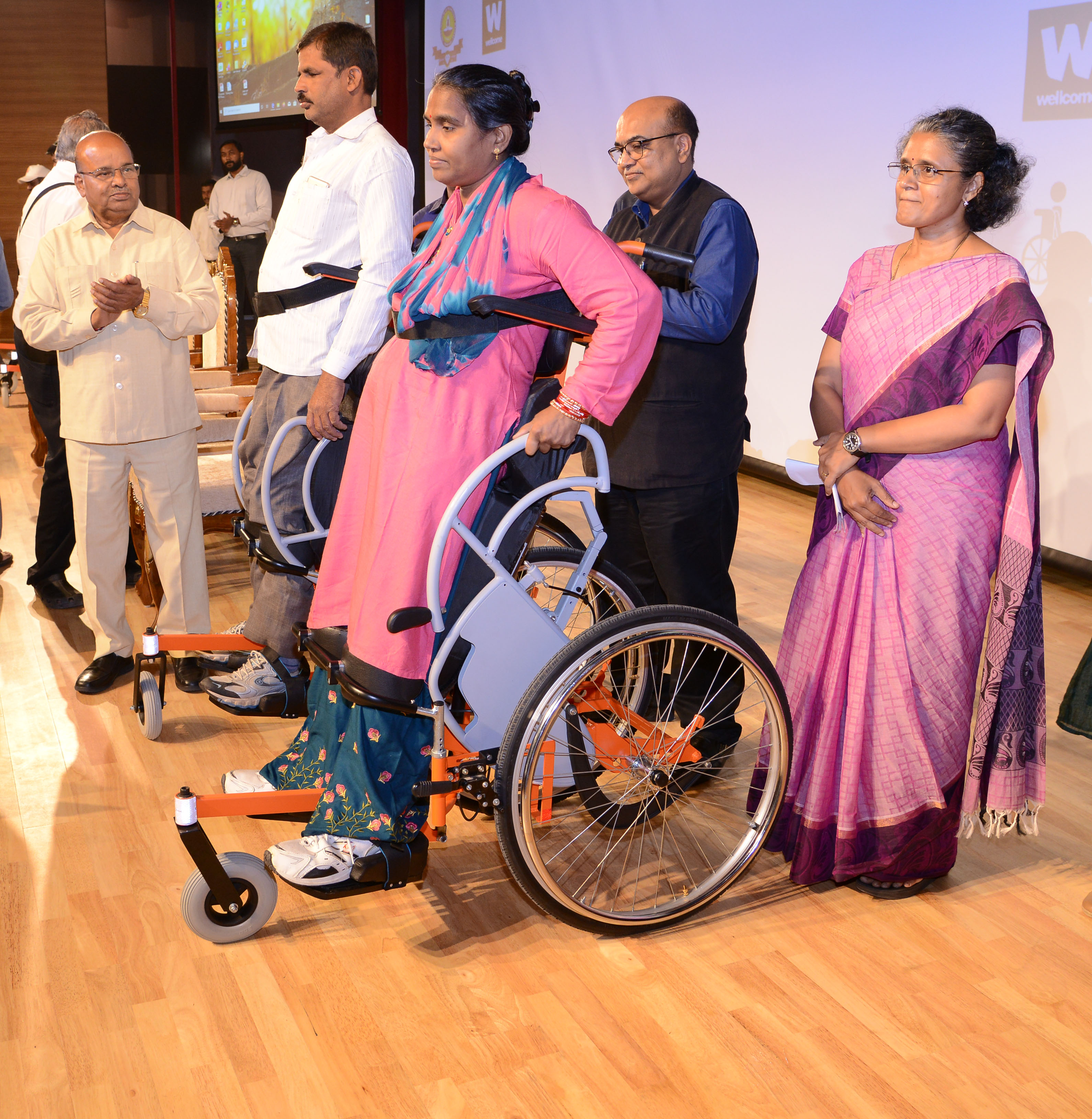Why IIT-Madras’s Affordable ‘Standing Wheelchair’ Can Be a Lifechanger for India’s Diff-Abled
It is built in such a way that that the effort required for the user to stand using it is equal to or less than that of moving the wheelchair. Brilliant!

The Standing Wheelchair launched earlier this week by IIT Madras, and Phoenix Medical Systems is what happens when innovation meets necessity and empathy.
Called ‘Arise’, it allows wheelchair-enabled people, to independently shift from sitting to standing position in a seamless and controlled manner.
Available for Rs 15,000, Arise was designed and developed at the TTK Center for Rehabilitation Research and Device Development (R2D2) in IIT-Madras under the guidance of Professor Sujatha Srinivasan, who teaches in the Mechanical Engineering department.
Since 2008, R2D2 has conducted intensive research on human kinesiology, designing and developing various devices for people with different physical impairments.
However, Arise would not have been possible without Wellcome Trust, a UK-based research charity, which, before even funding the project, also offered inputs on the proposal for commercializing the standing wheelchair, enabling the coming together of the research and manufacturing partners
Why is this innovation important?
The conventional wheelchair is great for mobility, but it comes with its own set of problems. For example, for people who use wheelchairs, prolonged seating results in a lot of secondary health problems such as poor blood circulation and pressure sores.
“It is essential that wheelchair users stand at least a few times a week to ensure lower limb health and blood circulation. Some weight-bearing on the legs will also ensure sure that the bones don’t deteriorate. However, this requires considerable effort, aid and assistance, which most do not have, so this tends to become an infrequent activity,” says Professor Srinivasan to The Better India.
Meanwhile, there is also a psychological component of standing freely.
“For young people, who once moved around freely, the entire experience of using a wheelchair poses a serious impact on their psychological well-being. They always find themselves in a seated position looking up to people and talking to them and need assistance at all times. It can affect their confidence and self-esteem. With the ability to stand, they become more functional. The ability to stand is a real life-changer for them,” she adds.

How was it designed?
As per a press release issued by IIT-Madras earlier this week, Arise was designed in three stages.
“In the first stage, a hand-operated, linkage-based mechanism was developed to achieve the standing functionality. A proof-of-concept prototype was used to validate the functioning of the standing mechanism.
Arise was designed such that the user can actuate it from the sitting position to the standing position and vice versa independently and in a controlled manner. This can be done using the power of the user’s arms.
With optimal one-time fitting, the effort required is no more than that required to propel the wheelchair. A gas-spring was a crucial element in reducing the effort expended by the user. This early prototype was tested by able-bodied persons.”
The wheelchair has been designed and built in such a way that that effort required for the user to stand using it is equal to or less than that of moving the wheelchair, as they have used a linkage with spring balancing system.
“We use gas springs that can be adjusted to suit the users weight. Irrespective of weight, we use the same gas springs. Its position can be adjusted in the mechanism and that helps us to customise it to each user’s weight,” says Professor Srinivasan.
The Standing Wheelchair has been more than five years in the making. But it was back in 2015 when the project seriously took off with R2D2 applying for funding from the Wellcome Trust.

“They worked with us to make the proposal viable, which is unusual because funding agencies don’t really engage in such assistance. They suggested that we needed an industry partner if the objective was to commercialize it. Colleagues in IIT Delhi introduced me to Sashi Kumar, the Managing Director of Phoenix Medical Systems, a pioneer in the medical devices sector. After Sashi saw our early prototypes, he told us that it could be done affordably. Fortunately, the funding from the Wellcome Trust also came through,” says Professor Srinivasan.
Two of her students, Swostik Dash and Vivek Sarda, decided to work on the project full time from 2015 onwards after obtaining their degrees and foregoing high paying jobs. They felt that the project could have a real impact on human lives.
“We worked on design and analysis, while Phoenix helped us build prototypes that underwent extensive testing. Thanks to S Vaidyanathan, the co-founder of The Ganga Trust, which supports rehabilitation of physically challenged, we were able to rigorously test our standing wheelchair on people with spinal cord injuries across various hospitals like CMC Vellore, nonprofits like Amar Seva Sangam in Tamil Nadu, APD in Karnataka, and rehabilitation centres, while receiving inputs from individual users and clinicians,” she adds.
Also Read: Eco-Friendly Recycling Method Helps IITian Increase Shrimp Production by 400%!
The team made field visits to several places to understand the conditions wheelchair users are living in. This really helped them understand what a wheelchair user goes through.
“One safety feature of Arise is the interlocking mechanism, which ensures that the wheelchair remains in a locked state if the knee block is not in position. The dimensions of Arise were made adjustable and adequate safety features were incorporated,” said Sashi Kumar, Managing Director of Phoenix Medical Systems.
Arise is being manufactured at a Phoenix factory in Puducherry. Although it costs Rs 15,000, Professor Srinivasan recommends that a one-time evaluation and fitting be done by a medical practitioner for optimal performance, which may entail further costs.
https://www.youtube.com/watch?v=Jnn343UbnGU
Even ministers have taken note of this game-changing innovation.
“I am really impressed by the kind of work done by the R2D2 Centre of IIT Madras and look forward to cooperating with them in the future. I assure IIT Madras and its partners that we will try to provide standing wheelchairs to the needy through the Ministry, MLA Constituency Development and CSR Funds. It will bring health benefits as well as the confidence to the users,” said Union Minister for Social Justice and Empowerment Thaawarchand Gehlot.
By any measure, Arise is a game-changer, and it is initiatives like this one that go a long way in making the lives of wheelchair users a tad easier.
Know more about the ATL Tinkering Innovation Marathon here.

(Edited by Gayatri Mishra)
Like this story? Or have something to share? Write to us: [email protected], or connect with us on Facebook and Twitter.

Similar Story

Startup’s Innovation Could Help Millions Get Access to Better Brain Health At Home
Ivory, a pioneering age-tech startup founded by Issac John and Rahul Krishnan, aims to redefine the ageing experience by focusing on better brain health, through neuroscience-backed assessments, interactive games, and personalised solutions.
Read more >
If you found our stories insightful, informative, or even just enjoyable, we invite you to consider making a voluntary payment to support the work we do at The Better India. Your contribution helps us continue producing quality content that educates, inspires, and drives positive change.
Choose one of the payment options below for your contribution-
By paying for the stories you value, you directly contribute to sustaining our efforts focused on making a difference in the world. Together, let's ensure that impactful stories continue to be told and shared, enriching lives and communities alike.
Thank you for your support. Here are some frequently asked questions you might find helpful to know why you are contributing?


This story made me
-
97
-
121
-
89
-
167












